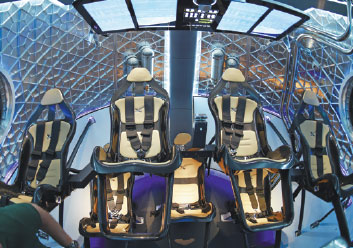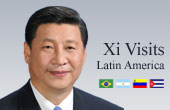Captains of industry explore new space frontier
By Agence France-Presse in Paris (China Daily) Updated: 2014-08-04 07:34
With spacecraft that can carry tourists into orbit and connect Paris to New York in less than two hours, the new heroes of space travel are not astronauts but daring captains of industry.
The new breed of space pioneer is using private money to push the final frontier as government space programs fall away.
Times have changed. Once the space race was led by the likes of the US space agency, NASA, that put the first man on the moon in 1969.
Today it is entrepreneur Elon Musk - the founder of Tesla electric cars and space exploration company SpaceX - who wants to reach Mars in the 2020s.
The furthest advanced, and most highly-publicized, private space project is being led by Richard Branson, the British founder of Virgin Group. His shuttle, SpaceShipTwo, will be launched at high altitude from a weird-looking four-engine mother ship that can carry two pilots and up to six passengers as it embarks on a three-hour suborbital flight.
Branson and his sons will be the first passengers aboard the shuttle during its expected launch later this year.
His company, Virgin Galactic, was given the green light in May by the Federal Aviation Administration in the US to carry passengers from a base in New Mexico, dubbed "Spaceport America" - the stuff of science fiction.
The $250,000 ticket price has not deterred more than 600 people, including celebrities such as actor Leonardo DiCaprio, from booking their seats.
The US spaceflight company XCOR is more affordable, offering a one-hour suborbital flight for $100,000 on a shuttle that takes off from the Mojave Desert in California. It has already sold nearly 300 tickets.
"The first prototype is being assembled. Hopefully, the test flights will begin before the end of the year, and commercial flights before the end of 2015," Michiel Mol, an XCOR board member, told AFP.
It plans four flights a day and hopes its frequency will eventually give it an edge over Virgin Galactic.
But the new space business is not just about pandering to the whims of the rich; it also hopes to address a market for launching smaller satellites that weigh less than 250 kilograms.
"There is no dedicated launcher for small satellites," said Rachel Villain of Eurocon-sult, a global consulting firm specializing in space markets. "Everyone has been looking for years for the Holy Grail of how to reduce costs, other than to send them as passengers on big launchers."
"These new players are revolutionizing the launch market," said aeronautical expert Philippe Boissat of Deloitte consulting. "They are smarter, cheaper, and they are reusable and don't leave debris in space."
Which is exactly what one newcomer, Swiss Space Systems, or S3, proposes. With a shuttle on the back of an Airbus A300, its founder Pascal Jaussi wants to start launching satellites before going into intercontinental passenger flights.
The 37-year-old former test pilot claims he can cut the price of a 250-kilogram satellite launch to around $11 million, a quarter of what it now costs.
"Satellite makers wanting to launch groups of weather and surveillance satellites have already filled our order books," he said.
The first test flights are planned for the end of 2017, and the first satellite launches will begin at the end of the following year from a base in the Canary Islands, the Spanish archipelago off northwest Africa.
For passenger travel, the new space companies have to be passed by the regulators who currently control air travel. At the moment a passenger plane covers the 5,800 kilometers between Paris and New York in seven hours. At Mach 3 speed, the S3 shuttle will do the same trip in one-and-a-half hours.
|
The interior of SpaceX's new seven-seat Dragon V2 spacecraft, the company's next generation version of the Dragon ship designed to carry astronauts into space, at a news conference in Hawthorne, California. Robyn Beck / AFP |
(China Daily 08/04/2014 page10)











